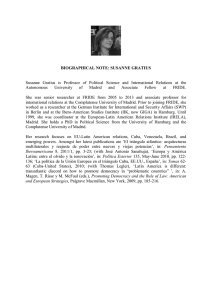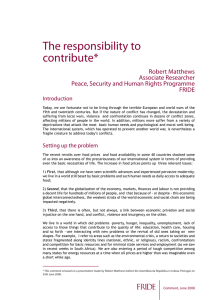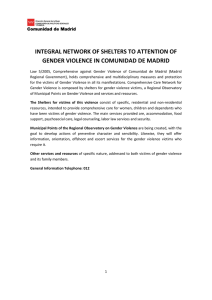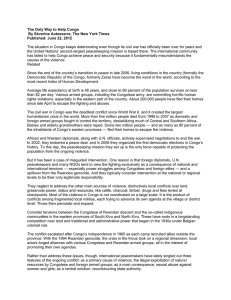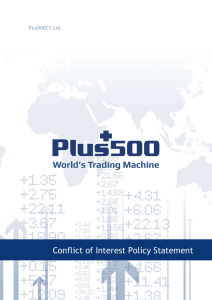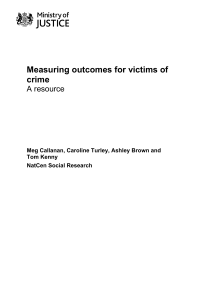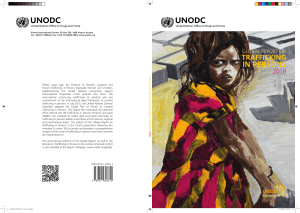Post-conflict as seen by the Victims
Anuncio
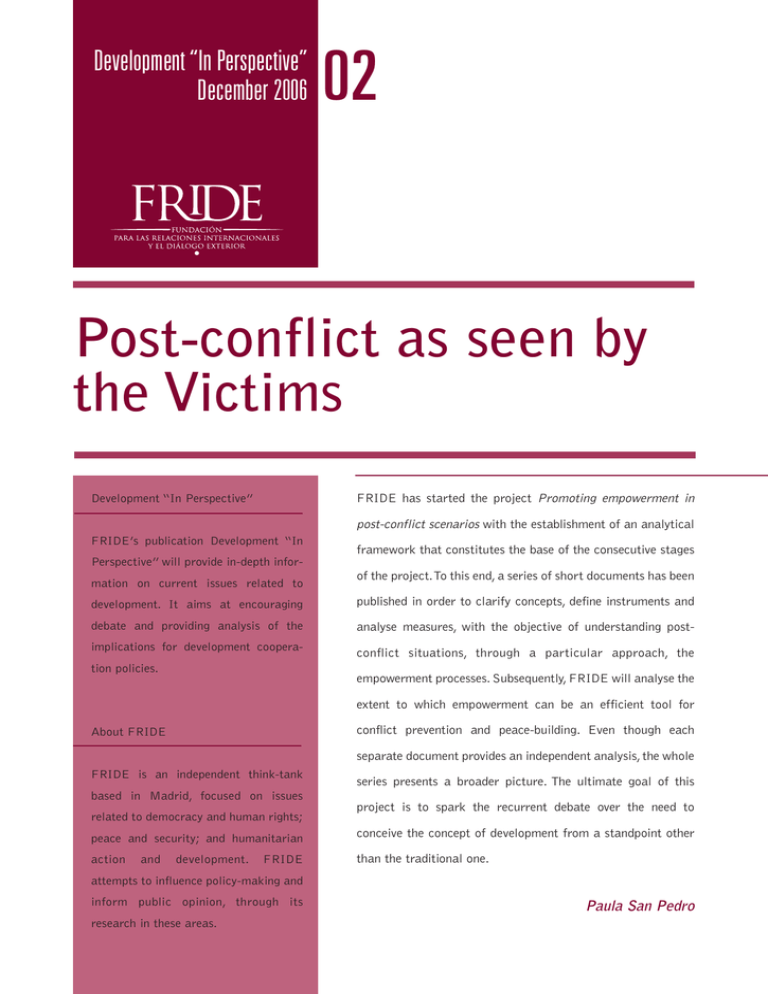
Development “In Perspective” December 2006 02 Post-conflict as seen by the Victims FRIDE has started the project Promoting empowerment in Development “In Perspective” post-conflict scenarios with the establishment of an analytical FRIDE’s publication Development “In framework that constitutes the base of the consecutive stages Perspective” will provide in-depth information on current issues related to of the project.To this end, a series of short documents has been development. It aims at encouraging published in order to clarify concepts, define instruments and debate and providing analysis of the analyse measures, with the objective of understanding post- implications for development coopera- conflict situations, through a particular approach, the tion policies. empowerment processes. Subsequently, FRIDE will analyse the extent to which empowerment can be an efficient tool for conflict prevention and peace-building. Even though each About FRIDE separate document provides an independent analysis, the whole FRIDE is an independent think-tank series presents a broader picture. The ultimate goal of this based in Madrid, focused on issues related to democracy and human rights; project is to spark the recurrent debate over the need to peace and security; and humanitarian conceive the concept of development from a standpoint other action than the traditional one. and development. FRIDE attempts to influence policy-making and inform public opinion, through its research in these areas. Paula San Pedro 2 Currently, more than 30 countries in the world find themselves in an extremely dangerous situation. In 2005, there were around 15 countries in conflict and 50 were trying to come out of a crisis.1 Despite the fact I. What is a postconflict scenario? that these figures vary according to the source, there seems to be no doubt that the transition from war to The term conflict refers to armed violence involving peace is no easy task; an estimated 44 percent of different types of groups such as military forces, countries in conflict relapse into violence during the guerrillas, armed groups, and paramilitary, religious or following five years after a peace agreement and 50 ethnic communities, which use arms or other percent reverse into conflict in the first decade of destructive methods. Conflicts are in theory measured peace.2 In order to reverse this situation, victims - the by their intensity level. A conflict may cause 25 direct invisible faces of conflict - have to be placed in the casualties per year, whereas a war goes up to 1,000 centre of the analysis and practice. The international casualties. While this is a useful quantitative criterion, development cooperation has not only to recognise other factors need to be taken into account: the their value, but also understand what is a post-conflict geographical extension of violence, the country’s total scenario, its causes and consequences before population, destruction levels and displacements intervening. caused by conflict.This study will use the term conflict in a broad sense and will apply it to all contexts, regardless of its intensity level. This is due to the fact that the abovementioned sense of the term is the most widely used in international terminology.3 Current armed conflicts – the so-called ‘new wars’ – are mainly internal conflicts with regional and international implications due, among other things, to the flow of refugees, arms trade, and political and financial relations they generate. Another significant 1 Megan Burke, ‘Recovering from Armed Conflict: Lessons Learned and Next Steps for Improved International Assistance’, FRIDE Working Paper Nº22, April 2006; and Informe de la Escola de Cultura de la Pau, 2006. 2 Paul Collier, V. L. Elliot, Håvard Hegre, Anke Hoeffler, Marta Reynal-Querol and Nicholas Sambanis, Breaking the Conflict Trap: Civil War and Development Policy, World Bank and Oxford University Press, 2003, p. 7; and ‘Aid, Policies and risk in post conflict scenarios’, 2006. Despite the fact that this figure has been extensively used, currently new revised figures reduce the percentage to 25. Regardless of statistics, the tendency to conflict resurge is the idea that wants to be highlighted. Development “In Perspective” 02 characteristic is the fact that 90 percent of conflict victims are civilians, whereas only 10 percent are military victims. In the early twentieth century, 3 The concepts of conflict and war also differ in that conflicts do not necessarily have to be violent or negative. More often than not they constitute normal elements in social relations and contribute to change. 3 however, the trend was the opposite. Another in countries with an income per capita of 250 dollars discouraging fact is that over one third of the are twice as high as in countries with a income per population4 is exposed to armed violence. Poor capita of 600 dollars. This suggests that poverty and countries are the most disadvantaged territories due low growth are associated with conflict, which in turn mainly to arms trade (75 percent goes into these reinforces the conditions for more poverty and even countries), corruption, and instability of their lower growth. For many countries, the conflict trap is institutions and states. The sum of these factors leads part of the poverty trap. There is also a strong direct to the risk of violence relapse being inevitably higher. link between low human development and conflict. In Thus, for instance, according to statistics, around 50 fact, violence is one of the fastest and most direct ways percent of conflicts are concentrated in Africa. to reach the lowest level of the Human Development Index (HDI). It is also one of the most important Chart 1. Number of armed conflicts in 2005 indicators of the country’s permanence in the lowest levels. Nine of the last ten countries in the HDI in 2005 Africa Algeria, Burundi, Ivory Coast, Nigeria, have at some point gone through conflict since 1990. Democratic Republic of Congo, Somalia and Uganda The other side of human development is human The Americas Colombia and Haiti Asia Afghanistan, security. This term refers to the concept of security the Philippines, India, Indonesia, Nepal, Sri Lanka and Thailand against major threats, and of protection against Europe Chechnya sudden changes in daily life. Conflict, therefore, Middle-East Iraq and Israel-Palestine undermines security in both dimensions: it reinforces poverty and devastates the lives of victims. Source: Escola de Cultura de la Pau Report, 2006 Due to the lack of a commonly agreed6 definition of While it is true that there is no direct link between post-conflict scenario, this study considers that post- poverty and conflict, it is also true that deeply conflict scenarios are time periods in which past polarised societies with weak institutions and acute hostilities have decreased to a level where poverty are more likely to resort to violence. There is, reintegration and rehabilitation activities can actually however, a direct link between growth and conflict. begin. When a conflict ends, the halt of violence must According to some studies,5 the chances of a civil war lead to an armistice agreement, which would help restore peace. This important moment is often 4 See F. Stewart and V. Fitzgerald, War and Underdevelopment. The Economic and Social Consequences of Conflict, 2000. 5 Macartan Humphreys, Economics and Violent Conflict, characterised by the return of refugees and of Cambridge, Mass., 2003. have a commonly agreed definition. 6 Other terms related to post-conflict such as peacekeeping Post-conflict as seen by the Victims December 2006 4 internally displaced persons. This term includes, have become powerful thanks to war. They also therefore, different types of scenarios that range from control the illegal market and intimidate the low-intensity conflicts to unstable peace or solved population. conflicts. Each of these scenarios, and their different variants, represent different levels of stability. However, Chart 2. Complex political emergencies they all have one thing in common: the acute humanitarian crisis is over, the reintegration process The term complex political emergency (CPE) was coined at the has begun and political and economic recovery is on United Nations to describe the main crisis situations that the right track. proliferated since 1989. According to the UN, a CPE is a humanitarian crisis of multi-casual nature. Some authors such Despite this, the difference between conflict and post- as Duffield,8 however, claim that CPEs are mainly conflict is still not clear. Today’s conflicts tend to be characterised by a long political crisis. In its broader sense, chronic and last for years, even decades, irrespective CPE are also identified with armed conflicts, displacements, of an eventual peace agreement. Apparently stable diseases and hunger. To that, it is necessary to add the weakening or failure of economic and state structures. Complex situations can suddenly become unsafe scenarios. It emergencies are often exacerbated by natural disasters and is, therefore, difficult to know when a conflict is over. inadequate transport networks. The response to this must, According to World Bank data,7 the chances of a therefore, be systematic and must include, among others, the conflict reappearing after the end of hostilities are as following actions: military intervention, peace-promotion high as 40 percent. The percentage is reduced by 1 activities, high-level diplomacy and aid programmes. percent every conflict-free year. Unfortunately, the most reliable indicator of a potential conflict is a past conflict. If not handled properly, post-conflict scenarios could be dangerous and the chances of conflict re-emerging could be high. There are various factors that account for these risks. Rebel groups with military capacities have emerged from the conflict, violence is used on a daily basis and people are ready for war. It must also be added that certain groups will have an interest in the rebirth of conflict given all the benefits they have got out of it for years. These are politicians, military men or traders, who 7 Paul Collier, et al, 2003, op. cit., p. 7. Development “In Perspective” 02 8 M. Duffield, ‘The political economy of international war: asset transfer, complex emergencies and international aid’ in J. MacRae and A. Zwi (eds), 1994. 5 represents 60 percent of Ethiopia’s total exports, II. What are the causes of conflict? Violent conflicts and insecurity do not simply occur. In most cases, conflicts develop and get worse over time. It must be said that each conflict is different and must be contextualised under its own parameters.There are, however, common elements that can be classified into five different domains: cocoa accounts for 40 percent of Ivory Coast’s exports and oil represents 92 percent of Angola’s export commodities. 3) Autonomy and independence. A minority group (sometimes also a majority) claims political power over a specific region for cultural, historical, political, economic or ethnical reasons. This type of conflict usually appears to defend an unsatisfied identity although there could be other factors that could worsen people’s marginalisation. 1) Political. It is characterised by weak institutions, an inefficient democratic system, a struggle for political power and high levels of corruption. In most cases, crises get worse because all these factors intertwine. As a consequence, the state fails to carry out its main functions up to the point where it cannot fulfil its obligations and responsibilities to society. 2) Economic. The economic factor that represents the highest risk is the dependency of a country’s income on raw material exports. According to some studies,9 if exports account for 26 percent of the GDP, the conflict risk could go as high as 23 percent. This factor explains to a great extent why most conflicts take place in poor countries, especially in Sub-Saharan Africa, where raw 4) Resources and population. The fight for access to natural resources (mainly land and water) could lead to conflict, especially in those countries without proper legal or institutional protection. Migration and displacements of local populations caused by them can also be a source of conflict as they could generate tensions among the local population. 5) Geographical. The geographic dispersion of the population can reduce a government’s capacity to control it (a clear example is the Democratic Republic of the Congo). Studies10 show that there is a 50 percent chance of conflict explosion in countries with high dispersion.This figure goes down to 3 percent in countries with a high concentration of population. materials are the motor of the national economy and the main export materials. For instance, coffee 9 See P. Collier, ‘Economic causes of civil conflict and their implications for policy’, Development Research Group, World Bank, 2000. Despite the above classification, it must be borne in mind that these causes are in most cases intertwined 10 Ibid. Post-conflict as seen by the Victims December 2006 6 and not isolated. On the political side, a weak institutional and state structure leads to parallel markets, income inequalities and inadequate distribution of resources. On the economic side, a rise in illegal trade activities could create a political system III. What are the consequences of conflict? in which inequalities are fostered and access to resources hindered. On the geographical side, a rise in Generally speaking, violent conflicts are extremely population could translate into a higher competence to harmful to societies as they could halt progress and access resources, education and job opportunities. human development achieved by many generations.The These needs will not be met if there is no solid, effective impact of conflicts depends on their nature, conflict institutional and social network. All these causal phase and duration, and their economic and social relations are an indication of the need to analyse background. Their effects are also linked to the conflict.This is the only possible way to understand the responses given by national governments and the specificities of a particular conflict and the scope of international community. A society that has just come the crisis. out of a conflict shows the following profile, adapted to its own context: a completely divided society, unequal Chart 3. Conflict analysis distribution of power, an urgent need to make justice and a major gap between victims and combatants. A conflict analysis is a systematic study of a conflict’s profile, its causes, its actors and its dynamics. It allows all The following lines will provide a detailed account of actors involved in a particular context to have a better the most common consequences in recent conflicts: understanding of the reality and their role. It also explains the relationship between intervention and context in order to avoid negative impacts and maximise positive ones. 1) Negative economic growth. The agricultural sector For all these reasons, a study must be carried out prior to is particularly affected with a direct effect on food any intervention. Because these types of scenarios change security. The conflict reduces economic activity and very rapidly, the analysis can never be in-depth or contain investment while external debt increases due to absolutely certain statements. The conflict dynamics are loans received during the conflict. The World Bank very complex and volatile. This is why a single conflict analysis cannot be accurate enough. The study will need, estimates that the average number of years in a civil therefore, to be adapted to the changes and the needs war is seven and that the economy’s growth rate is depending on how the conflict and the peace process evolve. reduced by 2.2 every year.11 With less resources and a lower capacity to face the loss of resources 11 See Paul Collier, et al, 2003, op. cit. Development “In Perspective” 02 7 and income, the poor are especially vulnerable to Chart 4. Conflict death toll the economic impact of conflict. Given that the definition of conflict is not clear, there are 2) High death toll (see chart 4). A worsening of the many problems to find out the total number of casualties health and mortality rates and a decrease of in a conflict. The sources are scarce and information is nutrition and education levels. The conflict destroys disparate. Measurements and methodologies vary as they the health and the educational infrastructures, reduces social expenditure and the few active services available can no longer be used due to are not consensually agreed. Also, until 2002 the World Health Organisation (WHO) was the only international organisation or entity offering this kind of information.To insecurity.The consequences of all these factors are this must be added the lack of overall information extremely high human costs and a decline in human regarding indirect casualties caused by a conflict. This is development. why we are unable to have an overall real picture of the impact caused by conflict. 3) Widespread destruction. Severe loss in terms of growth due to the weakening or destruction of all types of capital, production plants, land and human resources, as well social and organisational capital, and a decrease in investment in these domains. In this case we have taken two of the most cited sources that reflect some of the problems previously spotted. Despite not having more recent information to compare with, some trends can be highlighted: the number of casualties is decreasing considerably, conflicts are of low- 4) Increasing levels of national inequalities. These intensity and heavy armament is no longer used. lead to a malfunctioning of social integration systems. At another level, wars have an impact on Number of casualties WHO Lacina and Gleditsch 1998 97,893 588,000 1999 134,242 269,000 2000 99,536 235,000 2001 42,068 230,000 2002 19,368 172,000 social and family relations, which translate, among other things, into social confrontations, disappearance of association networks and subversion of the scale of values. 5) High levels of insecurity. Conflict erodes human security. Criminal violence becomes a generalised lethal threat and has strong effects on all spheres of society. It also generates chain reactions that perpetuate and spread fear.This is a key issue in social relations and will only disappear in future generations. Post-conflict as seen by the Victims December 2006 8 Several studies have shown that public goods, that is, goods and services offered by the state, are the most affected by conflict.12 Empirical evidence shows that this problem is balanced thanks to the supply given by IV. Who are the victims of conflict? emerging social networks, the flourishing informal market, rebel groups and humanitarian agencies. At a Determining who the victims of a conflict are can domestic level, those most affected by conflicts are poor become a difficult task given that all who go through a communities living in rural areas without land properties, war are potential victims.This is why listening to them without access to other types of income and outside is key to identifying the victims.They must say to what assistance networks.On top of that, the victims of conflict extent they feel victims. It is not about someone are the most tragic of all of the above mentioned determining who is a victim and who is not. Victims consequences, and whose recovery is essential to achieve must consider themselves as such according to their sustainable peace. Hence, they must be part of the peace personal feelings. Acknowledgment is the first step of negotiation and the decision-making processes. It is their recovery process as well as a basic element that through these processes that a conflict can be solved and will make them feel full members of society, capable of the chances of a conflict re-birth minimised. intervening in the public agenda.This is how they start building their empowerment process. In order to facilitate the work, victims can be divided into different categories. This should not exclude, however, what has been previously said. This classification is not the same for all contexts and will vary depending on the conflict. It must also be borne in mind that apart from direct victims there are many other sectors of society that suffer the consequences of conflict, even if they do not fall under any specific category. For illustrative purposes, the following lines provide the broadest and most common classification of victims: 12 F. Stewart, F.P Humphreys, and N. Lee, ‘Civil Conflict in Developing Countries over the Last Quarter of a Century: An Empirical Overview of Economic and Social Consequences’, Oxford Development Studies, Special Issue, 1997; G. Carbonnier, ‘Conflict, Post-war Rebuilding and the Economy: A Critical Review of the Literature’, War-torn Societies Project, UNRISD Occasional Paper 2, Geneva: United Nations Research Institute for Social Development, 1998. Development “In Perspective” 02 Women and girls This group is particularly affected due to its status in society. They are usually the first victims in a war, are 9 sexually abused and are often affected by other types as trauma, loss or uncertainty. Moreover, sometimes of violence such as homicide, sexual slavery, and forced they are HIV positive, victims of gender violence or pregnancy or sterilisation. In the socio-economic have been subjected to violence in refugee camps. sphere, conflicts tend to foster a decline in the well- Some are relatives of missing persons or have survived being of women. Conflicts shape a country’s torture. Their decision to unwillingly leave their demography and consequently women become heads of birthplace is never easy and they must deal with two family, having to support their families and relatives. conflicting feelings: feelings of despair when facing a They are so overloaded with new responsibilities that situation in which they are trapped and feelings of they must look for alternative types of income to resistance due to their willingness to save their lives survive (such as prostitution). To this are added a and those of their families. feeling of rootlessness, a lack of resources and the obligation to resettle in a community other than theirs, Their decision to leave is often traumatic.They are in a in which they do not have the traditional support. state of shock because they have left everything behind and are consequently unable to take the most Consequently, this social evolution associated with appropriate decisions. Upon arrival, expectations are conflict also brings changes in women’s roles. In some often unmet. In the case of refugees, they bear the pain cases, these changes have been extremely positive. An and survival problems endured during their journey and example of this is the key role played by women as it is when they arrive that they become aware of peace promoters and their capacity to develop skills psychological traumas. For their part, displaced unknown so far. This recognition has been reflected in persons face conflicting feelings: they feel foreigners in United Nations Security Council Resolution 1325, their own country and are at the same time which deals with the impact of war on women, and marginalised by local communities.While it is true that their contribution to conflict resolution and peace some refugees or displaced persons may not wish to go sustainability. back to their homeland because they have rebuilt their lives, it is also true that the feeling of not belonging to the host land perseveres. Refugees and displaced persons They are the unavoidable consequence of war and Ex-combatants persecution. There are currently around 40 million refugees and displaced persons. They face are not only Defining who is a combatant and who is not is not the lack of material goods and physical security, but always easy. Traditionally, ex-combatants were those also complex psychological destruction processes such registered in the command structure. However, combat Post-conflict as seen by the Victims December 2006 10 units include a great number of irregular combatants temporarily deployed such as women and children who Relatives of missing or murdered persons spread propaganda, transport material, take care of the sick and are forced into sexual services. There is When supporting this group, the most important also the question of how to classify relatives of element is to actually face the loss. This type of loss is combatants who move along with the troops and help always traumatic and results in a difficult mourning occasionally. Given the reality of modern wars, a process. It also has a political component since the demobilisation strategy must define the term dead are the most tangible expression of destruction. combatant in an inclusive way. It must also be as Knowing how to handle this is key to determining precise as possible to the conflict in question. whether a culture of war can be replaced by a culture of peace once the conflict is over. Some combatants are perpetrators; some are victims; others are both. Some have been forced to play that Families of missing persons also face the pain and the role while others have decided to fight voluntarily. uncertainty of not knowing where their relatives are. Some act as citizens of a state while others fight They either lack information or have some changing, because they identify themselves with the liberation questionable data. Over time, families learn how to live cause. Reintegration depends on how each of their with their new reality and focus their lives on the stories is tackled. Programmes must, therefore, avoid continuous search of the missing person. Uncertainty an unreal and potentially destructive homogenisation and instability are thus permanent realities in their of ex-combatants. During the conflict, ex-combatants everyday lives. Those who were dependants of the have fought, have witnessed violence or have suffered missing person live under a state for which society has it. All these questions become, either during or after the no name (a woman is not officially considered a widow conflict, major problems that could result in mental but does not have a husband either). crises. After a war, a combatant’s identity has no longer meaning. They are no longer members of the The more sudden and brutal the death and the less institution that gave them protection and a past accepted and integrated socially and politically, the identity. In civil life, they must evaluate their new more complicated is the mourning process. Even if this reality in which they question behaviour patters and in scenario is not characterised by uncertainty, having to which their past life still plays an important role. overcome the death of a relative is extremely difficult. Despite its complexity, this is a learning process that In several occasions, this depends on the manner of can also lead to a severe identity crisis. death - it is not the same to be tortured than to die in action. Families feel rage and guilt and go from passiveness to despair. Under these conditions, the Development “In Perspective” 02 11 mourning period is associated with fear of an upsurge of conflict and violence. V. A change in focus Apart from torn infrastructures, demolished buildings Tortured and political prisoners and useless services, there are devastated and torn societies. There is fear and poverty, and an increasing The main goal of torture is to destroy the victim both degree of vulnerability as time goes by.The risks people directly and symbolically. Physical violence creates a have to face are often exacerbated by social whole dilemma that succeeds in breaking a prisoner’s insurrection, violence and a permanent feeling of resistance. Prisoners are given the choice to either go insecurity. In addition, there is the presence of refugees against their personal convictions and therefore save and displaced persons whose interests often clash with their lives, or defend their principles and be sentenced those of the local population. Furthermore, if the time to death. Even if they are not political prisoners, they factor is taken into account, there are entire face the same dilemma. No matter what they decide – generations that have only experienced war and do not confess or not – their fate will be the same. The know other kind of life. Under these circumstances, destructive consequences of torture last for a long time human needs are multiple in the long-run but answers given that the victim’s mental structure is broken as remain insufficient. Humanitarian assistance cannot they believe they have actively participated in their own respond by itself and the local networks – whose main torture.They feel guilty and have lost their self-esteem. goal is to protect – are fragmented and have no choice The resulting trauma not only destroys their previous but to halt their activities. skills but also their learning potential. Also, their behaviour changes and becomes more aggressive and The solution, which is never easy, varies depending on self-destructive. the circumstances of each conflict.There is, however, an invariable and constant element regardless of location, origin, causes or consequences of a crisis. If we are to stop the upsurge of conflicts and the human destruction that they entail, we must inevitably include society in all spheres, institutions and in decisionmaking processes. This is why donors should give the population a role and offer the people the necessary tools and mechanisms to decide what kind of peace and future they wish for their country. Post-conflict as seen by the Victims December 2006 © Fundación para las Relaciones Internacionales y el Diálogo Exterior (FRIDE) 2006. All FRIDE publications are available at the FRIDE website: www.fride.org This document is the property of FRIDE. If you would like to copy, reprint or in any way reproduce all or any part, you must request permission. The views expressed by the author do not necessarily reflect the opinion of FRIDE. If you have any comments on this document or any other suggestions, please email us at comments@fride.org www.fride.org Felipe IV, 9 1º Dcha. 28014 Madrid – SPAIN. Tel.: +34 915 22 25 12 – Fax: +34 915 22 73 01. Email: fride@fride.org
